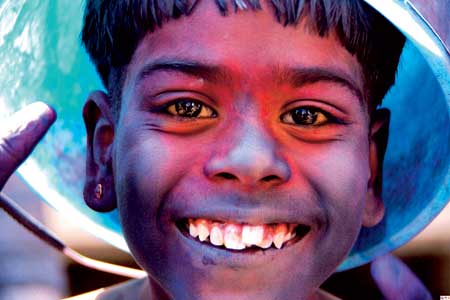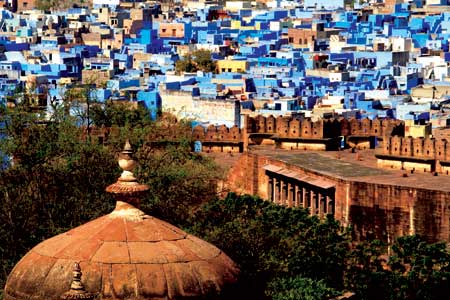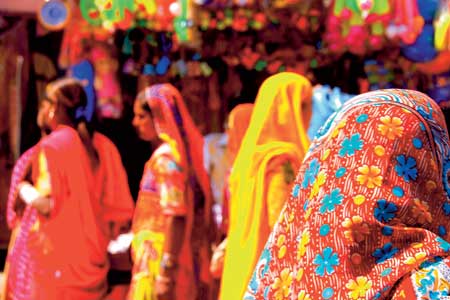
Reminisce in Rajasthan
Issue 58 July 2009
In the Venice of India Nabeel Shariff begins his search for the true Rajasthan, living amongst real Rajputs and breathing life back into the Maharajahs’ fairytale.
Scorched embers of a bonfire Holika Dahan from the night before lie strewn across the junctions of each neighbourhood, as the purple-stained faces race along deserted streets. The day of the Hindu festival Holi vacates Udaipur’s narrow alleyways, as people play amidst the colourful fog. Mopeds buzz through the streets, carrying Holi-goers hip to hip, awash with an assortment of colourful hues. The vintage angles of the city palace are reflected in the still of Lake Pichola; whilst her cousin Fateh Sagar, a short distance away, provides solace for couples taking a moment to reminisce. This year the festival of Holi fell during the same week as Eid Milad al Nabi, which marks Prophet Muhammad’s birthday and is widely celebrated in this part of India. The streets are littered with red crescent flags, and greeting signs hang between the modest homes. Families sit outside sipping chai, watching their Hindu neighbours shower each other with coloured powders. Here, in the heart of Rajasthan, the narrative of India’s mottled past is brought to life.


Rajasthan lies in the North West region of India, easily accessible from Delhi or Mumbai. For many first time visitors to India, their Rajasthani experience comes to an abrupt halt in Jaipur, after visiting the Taj Mahal in neighbouring Uttar Pradesh, and thereby completing the Golden Triangle. This well-worn trail is followed by hoards of tourists arriving from all corners of the globe. The comparatively ignored Southern and Western regions of Rajasthan have developed over the past few years, and yet still retain the hospitality that this region is renowned for. The gentle city of Udaipur lies seven hours west of Jaipur, past Ajmer, home of the famed Sufi shrine of Moinuddin Chisti. During the Mughal reign of Emperor Akbar, Ajmer emerged as an important centre for pilgrimages within India. Today the Dargahs (Sufi shrines) of India are revered by those who follow the Chisti order, as well as Hindus and Christians, all of whom descend upon the shrine to give offerings and take pleasure in the Qawwali (devotional music) singing that resonates from those quarters on most nights. The Muslim influence, stemming from the reign of the Mugals, can still be seen in the architecture and traditions of today’s primarily Hindu Rajasthan. Udaipur, home to the Kingdom of Mewar, lies south of the Aravalli ranges; its lush, rolling hills, which blossom following the monsoon season, contrast vividly with the parched spurs of the arid season, with the City of Lakes and Palaces ever in its shadows. The two dominating lakes are matched in splendour by the three palaces, each standing within sight of each other. The City Palace, an imposing maze builts over different eras, stretches back some 450 years. Each smaller addition to the palace is linked by narrow stairwells, adding a sense of mystery to the journey of the Maharajahs of a bygone era. Eventually, after traversing countless expansive courtyards and terraces, the majestic Monsoon and Lake Palaces emerge across Lake Pichola.

The Monsoon Palace perched on the top of a hill yields an enviable vantage point of Udaipur. Jag Niwas Island, or the Lake Palace, was the summer residence of the Sisodia rulers. At its zenith, this pleasure palace was full of secret passages, peepholes, and trap doors. However, in the 1960s, it began to fall into disrepair, suffering the same fate of many erstwhile palaces across India. Yet, the Lake Palace was spared this by the vision of Maharajah Jagat Singh II, who vowed to open the doors of the palace to the public, which ultimately led to its conversion into a luxury hotel. However, to truly immerse yourself in authentic Mewari hospitality, you must tap into the array of modish homestay options on offer: an opportunity which I decided not to pass by.
Hemant Kumari’s house lies in a quiet neighbourhood, which provides a calm backdrop to the mingling of the three major faiths. Her home stands a short rickshaw ride away from the Great Lakes; it is her pride and joy, a classic Haveli (courtyard house) boasting sculpted gardens that surround an open courtyard- a welcome retreat for house guests. Named Pahuna Haveli after their origins, this is the functioning home of Hemant and her husband in the residential area of Sardarpura. Their seven rooms are all unique in design, incorporating traditional fittings in a tasteful tone with some of Hemant’s own artwork peppering the walls. The owners’ heritage is an important part of my stay here: each portrait and newspaper clipping contains a story which can be recounted for hours by my hosts.
My hosts cordially invite me to an evening reception. This is quite common with homestays; during a wedding or festival you become more than a passing guest, and are welcomed into the family’s fold. An annual ceremony is held by the Maharajah himself within the grounds of the city palace. Guests routinely appear on the night, without invitation, by pre-booking a space at a fee; the evening is well worth the expense, with the celebration of Holika Dahan and a lavish reception in the company of the Maharajah afterwards.

After leaving Udaipur, I started heading into the Aravalli hills towards Jodhpur: the Blue City. The route by road lasts an entire day, with stops along the way enlivening the journey. After an hour of travelling through the winding hills, Kumbhalgarh Fort appears. Further along lie the Jain Temples of Ranakpur, dedicated to the first tirthankara or ‘enlightened one’. Together with Mount Abu on the Rajasthan-Gujrat border, the temples at Ranakpur house one of the best collections of intricately carved pillars and domes in India. As my journey continues beyond the Aravalli hills and we penetrate deeper into the Thar Desert, tell-tale signs of the harsh landscape begin to emerge. We enter rural territory, occupied by a unique set of villagers- the Bishnoi people. The Bishnoi are nature worshippers with a history dating back over 250 years to their first martyr, Amrita Devi. Their beliefs are centred around the protection of all living things. As testament to the strength of this principle, some 363 martyrs were decapitated whilst protesting the felling of a single tree by royal enforcers as early as 1730. The massacres came to a halt once the incident came to the Maharajah’s attention and the Bishnoi people were granted rights over protecting life in their land: an extraordinary tale of vanguard conservationists.
The city of Jodhpur is encompassed by the Umaid Bhawan Palace to the east and the Meherengh Fort to the west. The fort is one of the best preserved heritage sites in Rajasthan with a collection of historical artefacts dating back hundreds of years. The fort is also easy to navigate and the views of the patchwork blue city are breath-taking from its uppermost point. Walking down-town, it becomes clear that the Clock Tower Market is where the hustle and bustle of everyday life is concentrated. A labyrinth of alleyways and market stalls popular with locals makes an ideal observation point; whether watching pakora wallas (fritter sellers) serve snacks from their carts, or the colourful fabric shops piling their flamboyant stocks up high.

My homestay in Jodhpur is located in the High Court Colony, a quiet residential area on the outskirts of Jodhpur. Indrashan is run by Chandra Shekher and his wife Bhawana. Being related to the Maharaja of Jodhpur, the history of their family stretches back seven generations to the foundation of the city. The large home is built around a central, open air courtyard, where dinner is served if there are many more guests than the dining table can cater for. One of the advantages of lodging at a homestay is the chance to meet a variety of people; from fellow guests to eccentric family members, you will never be short of engaging dinner conversation. Dinner itself is a relaxed affair; home-cooked meals are the order of the day, in typical Rajasthani style. Vegetarian options are plentiful, and if you wish to take home a few tips, Bhawana runs a cookery class in the afternoon to show you the family’s secrets. Similarly, if you’re stopping in Delhi for a few days, Lakshmi at the Kotla Homestay can show you around her kitchen and also offers cooking classes. Running the homestay for over 20 years, her husband, the retired Major Chandra Kant Singh offers an alternative tour of Delhi for guests.
If you’re looking for a dinner under the stars, the Umaid Bhawan Palace is a must; for those yearning for some luxurious dining, there is no better destination. Overlooking the city and the Meherengh Fort, the Umaid Bhawan Palace is an opulent and stunning setting. With the residence of the Maharaja literally next door, a significant portion of the palace has been set aside for guests, managed by the Taj group. The ethos of hospitality is consistent with the attention to customers’ every comfort, which is catered for by the genuinely pleasant staff. If staying a night here seems a touch extravagant, then make sure you make a dinner reservation, allowing you to gaze out towards the candlelit gardens and starlit sky.

The final stop of my journey lies in the heart of the Thar Desert, a few hundred kilometres from the Pakistan border and a five hour train journey north west of Jodhpur. Rail travel adds to the Indian experience, and really should not be overlooked. The vast expanses that fleet by along the journey eventually lead to the scene of a camel-crossing outside the Jaisalmer Fort and the entrance of what could be a bollywood film set. Walking through the city, enclosed within the fort’s high walls, is a surreal experience; Havelis are scattered across the interior, the most striking being Patwon ki Haveli. The architectural beauty of these homes, owned by the descendents of merchants, stands as testament to the stature that they held decades ago. The interior of the fort is unfortunately suffering a slow demise however, due to the ageing infrastructure and the repercussions of an earthquake 200 miles away in 2001. Responsible tourism encourages visitors to stay outside the fort, unless guest houses are contributing to initiatives such as water conservation to protect the fort’s fragile future.
Rajasthan’s multifarious layers are as sweet and curious as their halwa (a traditional sweet) and what’s more, each bite leads to another. In many ways each stop along this journey has taken me to a home away from home; certainly, each homestay is unique, yet all are united by the hospitality offered by the hosts, who make every effort to secure the small creature comforts that many hotels cannot provide. Rajasthani fairytales come alive at every turn within this dramatic setting, in every imperial fort and with every Rajput smile.
For more information on homestays in India, visit
Bookmark this |
|
Add to DIGG |
|
Add to del.icio.us |
|
Stumble this |
|
Share on Facebook |
|
Share this |
|
Send to a Friend |
|
Link to this |
|
Printer Friendly |
|
Print in plain text |
|


Comments
0 Comments